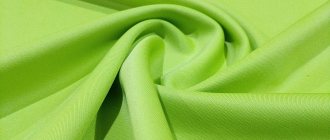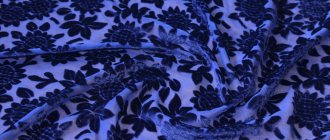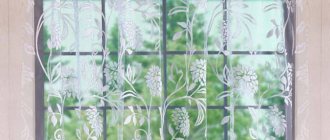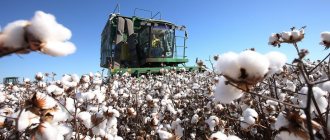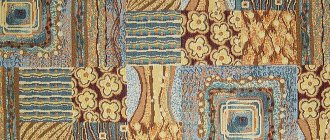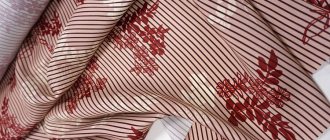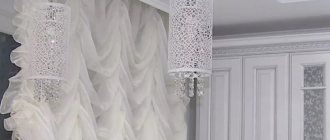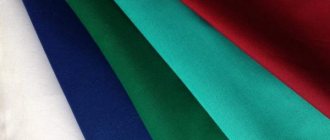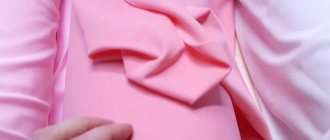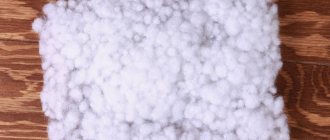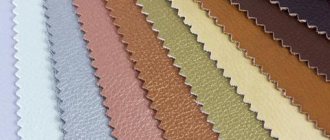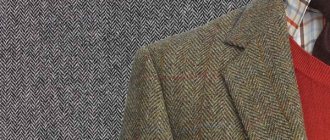Have a good day and good mood everyone! I invite you to plunge into an informative and interesting article about tweed. Ready? Well, then let's go! So what is tweed? Tweed is a fairly dense, elastic, very soft woolen fabric, which is mainly based on sheep's wool. Before we move on to the properties and characteristics of tweed, I also really want to tell you the history of the origin of the name of the fabric. I don’t know about you, but I’m interested in learning different kinds of stories related to the formation of something new.
1. History of the origin of tweed; 2. Tweed production technology; 3. Varieties of tweed; 4. Characteristics of tweed fabric; 5. Application of tweed fabric; 6. Caring for tweed fabric; 7. Customer reviews.
Fabric production and composition
Tweed material is made from the wool of mountain sheep. At the same time, the threads undergo minimal processing: they do not twist, so they turn out thick and with fibers. On the market you can find both 100% natural tweed and fabric with the addition of other natural and artificial threads. This improves the performance properties of the material - increases strength and wear resistance.
Tweed fabric is woven using a traditional twill weave, where the warp thread wraps around two or three weft threads. The texture of the fabric is ribbed, similar to gabardine or denim. The pattern is located diagonally on the canvas.
Wool fibers are dyed mainly with natural dyes, thanks to which tweed fabric receives deep and rich tones. Of course, the use of chemical paints also occurs; they allow you to achieve a durable and bright color.
Description and characteristics
What kind of fabric is tweed? Tweed is created from wool and has a diagonal weave. Wool obtained from Scottish sheep is used. The production technology remains unchanged. Only a few companies allow themselves to improve it.
Material made by hand is considered expensive. Natural dyes are used to make the fabric multi-colored. The properties of tweed fabric can be described in two words - durable and good quality. It is pleasant to the touch and soft. Bouclé fabric for coats is often confused with tweed, but their properties are completely different.
The main properties include:
- Resistant to fading and shedding.
- Durability.
- Resistant to stains and pilling.
- Protection from windy, wet and cold weather.
Types of wool processing for tweed production
With colored knots. Wool thread of uneven thickness with colored seals (knots).
Melange. The fabric consists of twisted threads, dyed in different colors. It turns out colorful, light and warm at the same time.
Mulinated. This is tweed made from twisted thin multi-colored threads. The fabric turns out colorful and attractive.
Features of care
Clothes made from tweed do not require much care, because the material is stain-resistant and almost wrinkle-free.
- For natural wool fabrics, hand washing is preferable.
- Pre-soaking should be avoided.
- Water no more than 40 C°. Otherwise things will shrink.
- Choose detergents designed for wool.
- Automatic washing is allowed in a special mode for wool.
- The synthetic variety of tweed is machine washable on a delicate cycle with a gel detergent without bleach. You can dry such things by hanging them away from sunlight and heaters.
- To dry, lay the products on a horizontal surface. It is worth noting that the fabric takes a long time to dry.
Tweed is self-healing. An elongated thread or puff returns to its place as soon as the fabric is stretched in different directions.
- Products should be ironed from the inside out and through a damp iron, and the heating should be selected according to the type of fiber.
- Tweed coats and jackets require dry cleaning to remove dust and dirt. This way things will last longer.
- To remove small stains, use a solution of ammonia or gasoline.
- Outerwear and lined items cannot be washed. They are periodically sent to dry cleaning.
- Woolen items need to be protected from moths using special means.
Tweed clothing is an eternal classic that is always in fashion. The fabric is used by famous couturiers in their collections; it often appears on the catwalks in unexpected interpretations.
Types of tweed fabric
Although the composition of the fabric is the same, the types of processing of the fibers and their weaving and coloring make it possible to create different fabrics of this type.
- Cheviot is a soft fleecy fabric. Consists of thin twisted wool threads in the warp and untwisted ones in the weft. They also produce half-woolen cheviot. Mostly, it is used to make women's and men's suits.
- Hering is a fabric with a special pattern, similar to a herringbone or fish bone.
- Harris tweed is a lightweight yet dense material. Harris is a separate tweed brand.
- Lace - tweed - lace woolen fabric.
- Covercoat - Bedford cord - is a fairly dense and heavy fabric. Weaved from twisted threads of two colors, the texture is ribbed.
- Donegal is a thin material, monochromatic with colored knots scattered throughout the fabric.
- Hounstout - the pattern on the fabric resembles a cage, but it is not clear, but rather blurred.
- Shepsford or shepherd's check is a classic type of tweed in black and white, gray or colored checks.
- Chanel tweed is an expensive luxury material. Produced to create fashionable clothes invented by designers.
Hounstout tweed
Chanel tweed
Donegal tweed
Covercott tweed
History of the origin of tweed
Nobody can tell you for sure why tweed is called tweed, but today there are two versions. According to the first legend, tweed was named after the Tweed River, which flows along the border of England and Scotland, where rich textile regions are located. But in another version, things are a little different. By the way, the second version is documented in the autobiographical book “Remembering Windsor” by the Duke of Windsor (former King Edward VIII). In it he talks about an incident that happened to a certain London merchant. When the merchant received a letter from his Scottish companion, in which he described the excellent qualities of a batch of new fabric sent for sale, due to poor handwriting, instead of the word “tweel” (which means a special way of twill weaving), he read “tweed”. At the same time, thinking that we were talking about the Tweed brand, named after the Tweed River. What kind of river do you already know?
Tweed production
It is worth noting that tweed was first obtained in the southern part of the Scottish Isle of Lewis and was called Harris. It was made from sheep's wool wound into thick, coarse threads. According to local traditions, the threads were dyed in the colors of bog moss and peat, and then woven into a houndstooth pattern. To soften the fabric, it was first soaked in soapy water and then beaten. Things made from real tweed protected from any rain and even heavy winds, which is typical for the homeland of tweed. The Scots are proud of their invention. You won’t believe it, but in the vast expanses of Foggy Albion, the technology for processing and dyeing natural fibers has still remained unchanged.
Advantages and disadvantages
Tweed is a very attractive fabric. And it has both positive and negative properties.
pros
- Naturalness, of course, comes first. Because this is important for normal air circulation under clothing.
- Retains heat and the body does not freeze.
- Resistant to damp autumn weather.
- Does not wrinkle and is easy to iron after washing.
- The soft and light texture of the fabric allows you to create unusually cozy things from it.
- Long-lasting color that does not fade in the sun.
- The attractive appearance of tweed allows you to sew formal and business suits and dresses from it.
Minuses
- In allergy sufferers, it may cause a reaction in the form of itchy skin.
- Pods may appear on the surface of the fabric.
- It takes a long time to dry after washing.
- Wool fabric may shrink when washed in very hot water.
- There is a possibility that the fabric will be damaged by moths.
- For young girls and boys, tweed items can make them look older.
Advantages and disadvantages of tweed
All the advantages of this material are derived from the characteristics of the fabric. Tweed also has a number of disadvantages. However, their number is much smaller than the number of benefits. The pros and cons will be discussed in more detail below.
pros
The advantages of tweed include:
- resistance to fading, because natural dyes are used to dye sheep wool;
- convenience;
- practicality;
- density. Thanks to this, you can sew warm clothes for cold seasons;
- wear resistance. If you buy a tweed jacket or jacket, it will last for several decades.
Minuses
The disadvantages of tweed include:
- price. Due to the quality, prices for the material are impressive;
- exposure to moths. This is due to the fact that natural wool is used;
- This type of fabric is preferred mainly by people of advanced age, for elegance and restraint.
What is made from tweed
After a detailed description of tweed fabric with the help of photos, it’s time to say what it is sewn from. A variety of wardrobe items and more are sewn from woolen fabric.
First of all, this is a fabric for sewing women's suits, skirts, dresses, jackets and coats.
Men also often prefer high-quality tweed jackets and trousers. In addition, riding clothes are often made from this tweed material, as it fits softly on the figure and is not blown by the wind.
In addition to clothing, tweed fabric is used to make bags, headwear (hats, caps), and even shoes (mainly sports sneakers or slip-ons).
Application of tweed fabric
In fact, you and I can find almost any clothing made from tweed fabric:
- Skirts, dresses, suits for women;
- Trousers, jackets, vests for men;
- Coat;
- Poncho;
- Sundresses;
- Warm shorts and breeches;
- Hats;
- Bags;
- and even sports shoes.
Initially, men's clothes were preferably made from tweed fabric: coats, suits, clothes for hunting and riding. For the first time, a women's tweed suit was presented by French fashion designer Coco Chanel. It was made in an elegant English style, with a fitted jacket and sheath skirt lined with silk. The novelty caused shock and disgust among the public, but soon became a style icon in the fashion world.
How to care for tweed items
Tweed fabric is very easy to care for. Incorrect washing or careless ironing can irreparably damage the product. Therefore, you should adhere to the following tips to maintain the integrity of the material.
Wash. Wash tweed by hand or in a machine on the delicate cycle. The temperature should not exceed 30 degrees. Choose liquid laundry detergents labeled “wool.”
Spin. If washed by hand, twisting the product is strictly prohibited. Just wring out the item slightly and let the rest of the water drain while lying in the basin. After machine washing, the spin cycle should be at minimum speed.
To prevent the fabric from becoming deformed, you should not leave it folded in water for a long time or twist it.
Drying. Dry the tweed item horizontally and straightened out. After the item is almost dry, it can be hung on the balcony for ventilation.
Ironing. After drying thoroughly, iron the product with a not very hot iron on the reverse side. For best protection, use damp gauze.
Storage. To keep tweed clothes intact for a long time, store them in a closet in a special case. And for better protection against moths, hang moth sections or plates in the closet that need to be changed after their expiration date. Cotton pads soaked in lavender oil will also protect against moths.
How it is produced
Classic tweed is made from the wool of English Merino sheep. The process of obtaining fabric is clearly established and occurs according to established traditions.
After shearing the sheep, the resulting wool is cleaned, carded and dyed. Coloring occurs with natural dyes - components of herbs and plants. A thick thread is formed from the prepared wool. Fabric is made from twill or plain weave yarn.
- Twill weaving is a diagonal weave with an asymmetric shift in the intersection of the warp and weft threads 1 through 2 or 1 through 3.
- Plain weave - one warp thread is intertwined with one weft thread.
The material turns out to be rough and prickly to the touch. To make it soft, it is soaked in a soap solution.
The final stage is the production of the finished fabric. The fabric is dried, steamed and ironed to a flawless appearance.
Reviews
Angela : I’m wearing a warm tweed coat for the third season. It is very warm and comfortable in any winter weather, and special plates protect it from moths during the warm season.
Oleg : A tweed jacket was given to me for a wedding. I've been wearing it for many years and it's like new. No puffs, no pellets, the color is bright and rich. This is what quality material means.
Marina : I sew autumn tweed suits for children. The jackets and trousers turn out very cute, you can’t buy these in the store. And most importantly, they are very warm.
Manufacturers and brands
There are thousands of tweed manufacturers on the textile market. British companies are considered the main suppliers of traditional high-quality fabric.
- Harris Tweed is a company that has preserved ancient production methods. The canvas is made on manual machines, dyed with natural dyes, and has a certificate of high quality products. The company produces more than a million meters of tweed per year.
- Linton Tweeds is a favorite fabric manufacturer of Chanel fashion house designers.
- Dashing Tweeds - designer tweed collections from this company annually conquer the catwalks of Paris, Milan, London and other world fashion capitals.
Impeccable properties
The fabric of the Victorian royal court, worthy gentlemen and sophisticated aristocrats has special properties.
- Versatility. Tweed is equally good for relaxation and high receptions. This is exactly the fabric that is appropriate in any society and in a wide variety of settings.
- Attractiveness. The fabric has a beautiful textured texture and different colors.
- Comfortable to wear. The material is elastic, soft, pleasant to the touch and quite light.
- The twill weave explains the fabric's durability. In addition, it practically does not wrinkle.
- Extreme durability comparable to denim and gabardine.
- Tweed dyed with natural dyes does not fade in the sun.
- Excellent protection from cold and wind. The reason for this is natural wool raw materials and the increased density of the material.
- Tweed fabrics are self-healing. If you accidentally catch on a branch while hunting or cycling, the resulting hole will disappear under your hands. To do this, simply pull the fabric in different directions.
Some cons:
- Natural wool fabric is moth-resistant.
- Classic tweed can add not only solidity, but also age. However, the product will not add years if some carelessness in the cut is allowed. The inclusion of light fabrics and bright accessories will add youthful notes to the ensemble.
Types and their properties
The varieties of tweed can take your breath away. They differ in purpose, characteristics, manufacturer, color. The palette of tweed fabrics is usually practical and moderate, but modern mixed fabrics often have unusual shades. In clothing collections, along with gray, black-and-white and brown items, items in pink, yellow and blue tones appear. And blue tweed is considered one of the most popular in the production of business suits.
The main types of tweed include:
What kind of fabric
Tweed is a fabric that was invented by the Scots. In English, tweed sounds like tweed, which is similar to the name of the river in Scotland - Tweed. At the same time, the material was originally called “twill,” but in England the names were mixed up and “tweed” was assigned to the fabric.
According to the description, this is a dense and rigid material obtained by twill weaving. Such characteristics make the material unique, which allows it to be used in the manufacture of outerwear. Coat fabrics include drape and bouclé, which have similar properties. However, tweed fabric remains a favorite among coat materials.
There are many varieties of woolen fabric, which differ in density, appearance and composition. All tweed variations have a characteristic relief and grainy pattern, which is achieved by diagonally weaving the threads. Denim and gabardine are produced in a similar way, but tweed fabric has a recognizable appearance and textured surface. Suit fabrics, unlike coat fabrics, are characterized by smoothness and softness.
We found out what tweed is, now let's talk about the composition of the material and its properties.
